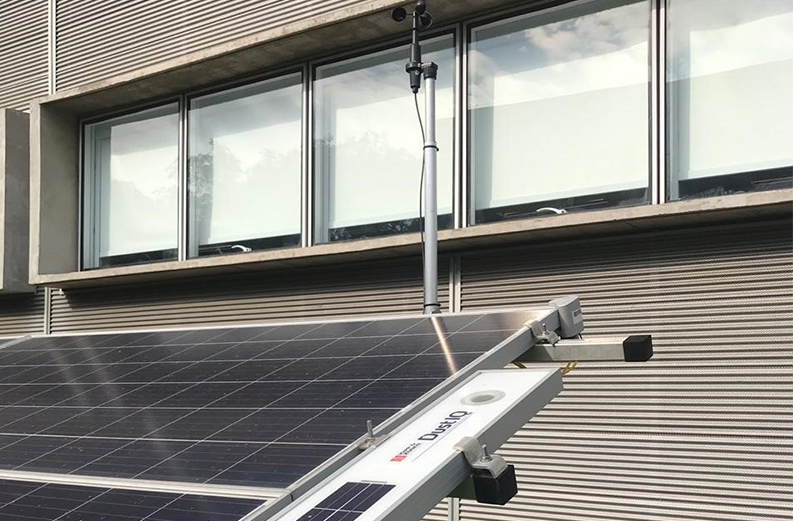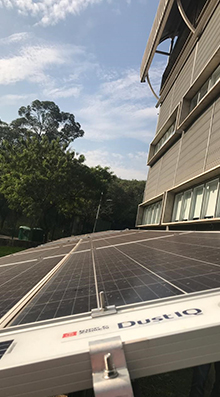DustIQ part of the photovoltaic system at the University of São Paulo
Published: Thursday, June 20, 2019
The DustIQ has been added to the experimental 5.85 kWp photovoltaic system of the Interdisciplinary Center on Interactive Technologies of the University of São Paulo (CITI-USP) in Brazil. This system carries out scientific research and evaluation of new devices for monitoring and optimizing the performance of photovoltaic systems.
The CITI-USP is a platform at the Capital Campus of the University of São Paulo for multidisciplinary projects widely available for use by the scientific community of the University and by cooperating scientific institutes. The test set-up is divided into 3 independent PV tables with adjustable inclination between 0 and 40 degrees.
For each PV table the AC and DC electrical parameters (current, voltage, power, etc.) of the inverter are monitored together with a Kipp & Zonen RT1 smart rooftop monitoring system fitted to the upper right corner of each PV table, which measures irradiation in the inclined plane and the temperature of the PV modules. In addition, each table is fitted with a DustIQ soiling monitoring system. Other parameters; such as wind speed, atmospheric pressure, rainfall, air temperature and humidity are also monitored at the site of the photovoltaic system.

The objectives of this study are to:
- Characterize soiling in large Brazilian metropolises;
- Study the influence of shading in the generation of photovoltaic energy in urban environments;
- Develop new applications for photovoltaic systems management through field data in conjunction with Artificial Intelligence (AI);
- Evaluate the effectiveness of the use of Data Analytics for the identification of failure patterns and anomalous behaviours that result in increased availability and performance of photovoltaic systems during their useful lifetime.
With the DustIQ measurements we aim to study soiling patterns in the region for future scientific publications and the development of new technologies.
We intentionally left 30 cm (≈12 in) extra of the metal support bars for the PV modules at the side of each of the 3 tables to allow for mounting of the DustIQ and the installation was very easy to perform with the supplied mounting fixtures. The integration of the DustIQ data was simple and easy with the Campbell Scientific CR1000X data logger.
The reason to buy DustIQ was the fact that this sensor was the first in the world able to perform soiling measurements without the need to use two reference photovoltaic modules, one constantly cleaned and another for soiling deposition. DustIQ allows more flexibility in operation during field experiments.
The concept of DustIQ is very interesting and promises to significantly change the way O&M is performed in large photovoltaic systems. At the moment, I have not yet performed the measurements of each string through a PV Analyzer and IV Curve Tracer, to determine the losses by soiling after the washing procedure of the photovoltaic modules and comparing them with the reading variation registered in DustIQ.
Soiling is not uniformly deposited over the photovoltaic system, that’s why the ability to calibrate the DustIQ is a great benefit and helps to increase the accuracy of the measurements at several points.
It would be very helpful if there was software to estimate the calibration parameters using the increase of performance of a PV array. If the system has the measurements of temperature and solar irradiation on the tilted plane, utilizing a sensor like the Kipp & Zonen RT1 smart rooftop monitoring system.
For example, during a visit to the CPFL Energia Tanquinho plant in Campinas, São Paulo, I witnessed a cloud of dust from the plantations next to the site that deposited on the plant PV modules. This dust deposition is very similar to ATD and the calibration procedure has more chances of success in first year of installation, contrary to my case study which is performed in a large green area in Sao Paulo, Brazil.
The DustIQ will be most useful in our projects and I am very likely to recommend it to colleagues in Solar Energy.

Testimonial by Cesar Biasi de Moura, researcher at USP (University of São Paulo).
Click here to request a quote